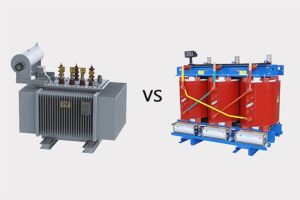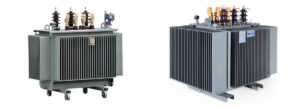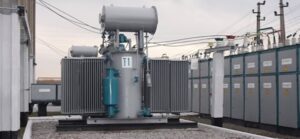
Oil-Immersed Transformers: Structure, Working Principle, and Applications
1. Introduction to Oil-Immersed Transformers
The power transformer is a crucial component of the power system, responsible for voltage conversion and energy distribution. The design of grid transformers varies depending on the cooling and insulation system used. Transformers are broadly classified into dry-type transformers and oil-immersed transformers, with the latter being more widely used.
Also known as oil-filled transformers, oil-immersed transformers use insulating oil as both a cooling and insulation medium. They are widely applied in urban and rural power grids, industrial and mining enterprises, as well as in combined substations and prefabricated transformer stations. Compared to dry-type transformers, oil immersion provides better heat dissipation, enabling higher-rated power and improved efficiency.
This article provides an overview of oil-immersed transformers, covering their structure, working principle, types, advantages, and maintenance requirements.
2. Structure and Working Principle of Oil-Immersed Transformers
2.1 What is an Oil-Immersed Transformer?
An oil-immersed transformer is a type of power transformer in which the internal components, including the core and windings, are submerged in insulating oil. This oil serves two primary functions:
- Cooling: It absorbs heat from the windings and core and transfers it to external cooling components.
- Insulation: It prevents short circuits and suppresses electrical discharges.
The main components of an oil-immersed transformer include:
- Iron Core: Conducts the magnetic flux and minimizes energy loss.
- Windings: Primary and secondary coils wrapped around the core to induce voltage transformation.
- Tank: A sealed container that holds the transformer oil and internal components.
- Bushings: Insulated connectors that link the internal windings to the external electrical network.
2.2 How Does an Oil-Immersed Transformer Work?
The operating principle of an oil-immersed transformer is based on electromagnetic induction:
- Voltage is applied to the primary winding, generating a magnetic field in the iron core.
- The changing magnetic flux induces a corresponding voltage in the secondary winding.
- The voltage is then stepped up or down, depending on the winding ratio.
- The generated heat is transferred to the oil, which circulates within the transformer to maintain stable operating temperatures.
Cooling methods vary:
- For small transformers, heat dissipates through the transformer tank.
- For larger transformers, external cooling systems like air-cooled radiators are used.
The transformer oil plays a critical role in ensuring both electrical insulation and heat dissipation, making it essential for the transformer’s efficiency and longevity.
3. Oil-Immersed vs. Dry-Type Transformers
3.1 Oil-Immersed Transformers
In oil-immersed transformers, the core and windings are fully immersed in special transformer oil, which acts as an insulation and cooling medium. This design:
- Prevents air and moisture exposure, reducing corrosion and oxidation.
- Extinguishes arcs, enhancing safety.
- Supports higher voltage levels, making it suitable for large-scale power applications.
3.2 Dry-Type Transformers
Dry-type transformers, on the other hand, use air instead of oil for cooling and insulation. Their core and windings are often coated with resin or varnish. Key characteristics include:
- No risk of oil leaks, making them safer for indoor environments.
- Lower maintenance requirements, as no oil purification is needed.
- Higher sensitivity to temperature and humidity, requiring controlled environmental conditions.
While dry-type transformers are common for indoor installations, oil-immersed transformers remain the preferred choice for high-power applications, outdoor settings, and industrial use.
4. Advantages of Oil-Immersed Transformers
Oil-immersed transformers offer several key benefits over dry-type transformers:
4.1 Cost-Effectiveness
- Typically 50% cheaper than dry-type transformers of the same capacity.
4.2 Superior Cooling and Efficiency
- Oil is a better heat conductor than air, allowing oil-immersed transformers to operate at higher power ratings with greater efficiency.
4.3 Higher Voltage Capacity
- Dry-type transformers typically operate at voltages up to 35 kV, whereas oil-immersed transformers have no such limitation.
4.4 Environmental and Space Efficiency
- Oil-immersed transformers are more compact and easier to recycle than dry-type transformers.
- Ideal for outdoor applications, where oil leaks or safety concerns are less restrictive.

5. Common Types of Oil-Immersed Transformers
5.1 Single-Phase Transformers
- Use one pair of windings (primary and secondary).
- Common in low-load rural power distribution.
5.2 Three-Phase Transformers
- Comprise three windings wrapped around an iron core.
- Used in high-load areas for industrial and commercial power supply.
5.3 Power Transformers
- Step up or step down voltages to facilitate electricity transmission.
- Handle higher power loads in transmission networks.
5.4 Distribution Transformers
- Reduce high-voltage transmission power to lower voltages suitable for homes and businesses.
- Smaller in size than power transformers.
5.5 Pole-Mounted Transformers
- Installed on utility poles, used for overhead power distribution.
5.6 Pad-Mounted Transformers
- Installed on concrete foundations, often used in urban underground distribution networks.

6. Transformer Oil: Properties and Importance
Transformer oil, also called insulating oil, is essential for the transformer’s cooling and insulation functions.
6.1 Key Properties of Transformer Oil
- High Dielectric Strength – Prevents electrical discharge and ensures insulation.
- Thermal Stability – Resists degradation over time.
- Controlled Viscosity – Maintains efficient heat transfer.
- Purity and Cleanliness – Requires regular filtering to remove contaminants.
Mixing different grades of transformer oil is not recommended, as it may affect performance and safety.

7. Selecting the Right Oil-Immersed Transformer
Choosing an oil-immersed transformer involves considering several factors:
- Load Requirements – Ensure the transformer has adequate capacity for peak loads.
- Input and Output Voltage – Select a model that matches voltage conversion needs.
- Environmental Conditions – Consider moisture resistance, corrosion protection, and explosion-proofing.
- Maintenance and Lifespan – Opt for reliable brands with low maintenance costs.
- Safety Features – Ensure the transformer includes overload and short-circuit protection.
- Budget – Balance cost-effectiveness with performance and durability.

8. Maintenance and Safety Considerations
To ensure long-term reliability, oil-immersed transformers require regular inspection and maintenance:
8.1 Routine Maintenance
- Check for oil leaks, as they can cause insulation failure and fire hazards.
- Clean the transformer’s external surfaces to prevent overheating.
- Monitor oil levels and quality to maintain optimal insulation properties.
8.2 Fire and Environmental Protection
- Transformer rooms must comply with fire safety regulations.
- Proper containment measures should be in place to prevent oil spills.
- Used transformer oil should be disposed of responsibly to minimize environmental impact.
9. Conclusion
Oil-immersed transformers remain the preferred choice for high-power applications due to their cost efficiency, superior cooling capacity, and higher voltage tolerance. Although they require regular maintenance and pose potential safety risks, proper handling and periodic inspections can maximize their lifespan and performance.
By understanding the structure, advantages, and maintenance requirements of oil-immersed transformers, users can ensure safe and efficient operation in power transmission and distribution systems.
Professiona Switchgear supplier and manufacturer
- Zhejiang GONGSHUN Electrical Co.,Ltd (electricgs.com), Our company was founded in the late 1990s, specializing in the production of inflatable cabinets, SF6 inflatable cabinets, and various high and low voltage complete sets of electrical equipment. It has multiple subsidiaries under its jurisdiction, including high-voltage load switch branch, high-voltage circuit breaker branch, high-voltage fuse branch, and technology development branch.Our technical expertise, comprehensive product portfolio and long-term rich experience are helping many customers in need to solve their power problems. We’re happy to help at any time. Whether you need application product advice or technical assistance, our global service team is committed to providing you with the right support. For more technical information about medium voltage earthing switch, feel free to contact us, send an email to gongshun@electric-cn.com
- Our company specializes in producing 12KV-40.5KV series high-voltage electrical products: FZN58, FLN48, FLN36, FZRN25, FZN21, FN18, ZFN16, FN12, FN8, FN7, FN5, XRNT, XRNP, VS1, ZN28, ZW8, ZW32, JN15, GN19, GN22, GN24, GN30, CLXGN15-12, HXGN □ -12, DXG-12 (L), DFW □ -12 high-voltage cable branch box, CLXGN □ -12 (SF6) series inflatable cabinet 12KV and 35KV cable accessories, etc; CLVXP-12 indoor AC high voltage fixed switchgear, CL-SIS-12 compact solid insulated ring main unit, professional assembly Schneider SC6 (SF6) series load switchgear, ABB produced SFG (SF6) series load switchgear and other series products; Distribution and agency of high-voltage load switches and inflatable cabinets produced by Schneider Electric and ABB; Siemens produces the 3AJ1 series of indoor medium voltage vacuum circuit breakers and other related products. The company has a complete range of products and has been operating safely on domestic and international power grids for a long time, receiving unanimous praise from both new and old users. Among them, multiple products such as FZRN25, FN12, FLN36-12, XRNT-12 have been exported to various countries and regions in East Asia, South Asia, Southeast Asia, Africa, and the United States.
